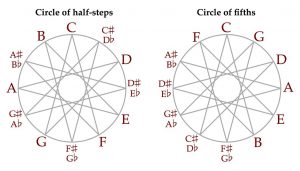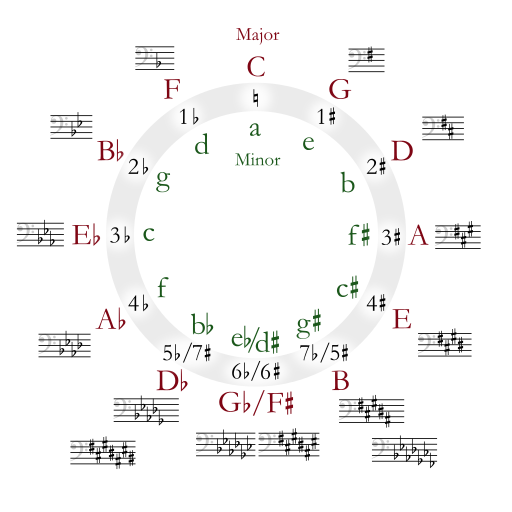Even if you’re asking yourself right now, “What is the Circle of Fifths?” it’s probably come into your life before – maybe without you even realizing it. It’s a staple for music room interior design, and it’s something that every musician loves to have close at hand.
Those who missed the boat on starting their classical piano training shortly after birth might feel intimidated when someone starts to explain what is the Circle of Fifths, especially when music theory already seems complex enough for them. Luckily for anyone just starting out on their musical journey, the Circle of Fifths explained actually serves to make music less complex, not more.
Anyone who’s ever taken a look at an advanced piece of sheet music or hieroglyph-esque jazz chord symbols already knows that there are numerous shapes used in the world of written music. Something that makes the Circle of Fifths such a particularly special shape is the fact that it visually describes a musical relationship as elegant and beautiful as the geometric shapes themselves.
A History of the Circle of Fifths
This musical tool was pioneered – most likely – by none other than Pythagoras, an ancient Greek philosopher whose theorem is still the bane of many math students to this day. Historians theorize that around 600 B.C., Pythagoras was tinkering away at a harplike device made of various string lengths. By plucking them and studying their vibrations, he was allegedly the first person to shed light on the relationship between pitches.
This discovery has enabled a deeper understanding of music and created more opportunities to push the boundaries of music theory – nowadays with such genres as experimental and progressive rock.
One of the direct discoveries that Pythagoras is commonly credited with is the precise definition of an octave – two notes, one with twice the vibrational frequency. This is easy to identify as the first and last notes of a major scale, or the “Somewhere Over the Rainbow” interval.
After tackling the octave, Pythagoras went even further and broke this tonal relationship into 12 perfectly equal pieces. These are what would become the half-steps of the chromatic scale that Western music students still practice rigorously as they work to master “Flight of the Bumblebee.””

Now that Pythagoras was satisfied with his breakdown of vibrational relationships, he wanted to express his discoveries in a visual way – perhaps one that music majors everywhere could put up on their dorm walls thousands of years in the future. Since the octave led to a repeating pattern, he found a circle to be the perfect shape for his work, and thus, the Pythagorean Circle was born.
From there, other pioneering music theorists like Nikolay Diletsky and Johann David Heinichen made improvements to Pythagoras’s work in the 1670s and 1728 respectively. This is how we’ve come to the circle that composers and music teachers know and love today.
What Does the Circle of Fifths Show?
Musicians don’t just go on and on about this nifty chart simply because it looks cool. If you really know how to use it, the Circle of Fifths explained conveys a surprising amount of information.

Primarily, this tool is used as a map of key signatures. When the note names on the chart are seen as key signatures, it can be an incredibly helpful musical cheat sheet when you’re trying to understand what key/scale to play in.
Starting with the key of C major on the top – no sharps, no flats – and moving around the circle, the key signatures closest or adjacent to each other are always the most similar. If you go clockwise, you just add one sharp each time, or one flat for counter-clockwise. This goes on both ways until the key signature is crammed full of seven sharps or seven flats, C sharp major or C flat major respectively. Whether or not those are keys that any sane human would want to play in, the Circle of Fifths provides an easier way to analyze them.
Key changes are one way that composers keep a song sounding interesting without actually writing anything new. With every key in the known musical universe mapped out, it’s easier than ever to get from one key to the next. Since similar keys are grouped next to each other, you can visually work your way around the wheel until you get to the key that’s perfect for your big oboe solo.
Minor Keys on the Circle of Fifths
So far, we’ve only just scratched the surface of this musical ring’s potential. A complete Circle of Fifths includes an inner ring nestled inside the circle of major key signatures; these are the minor keys relative to their major counterparts. For example, under C major you’ll find A minor, under G major is E minor, and so on.
With this minor addition, the chart can be used to create chord progressions in any key. Some skeptical composers might worry that this takes the creativity out of the process and reduces it to a cold, calculated formula, but this couldn’t be farther than the truth.
There’s such an infinity of possibility in music that no matter how formulaic a method for writing chord progressions might be, the composer’s creative imagination has to be involved in the musical experimentations one way or another. Rather than robbing you of your creativity, this circle makes it far easier to be creative, giving you all the chords at your disposal right in front of your face.
If you look at the wheel in sections, you’ll see that diatonic chords – the ones that naturally occur within a key signature – are grouped together. With a quick glance at the relevant slice of this music theory pie, composers and songwriters of any level have visual access to all the options, making it possible to pick even more emotionally moving chord changes.
But Wait…There’s More!
Writing harmonies with the help of this chart cuts out a lot of the piano hunching and note counting since you can easily refer clockwise or counterclockwise and get the fifth or fourth interval of a note. This is also useful when building triads.
As if all that weren’t enough, this circle can also give you the names of the sharps and flats in any key signature. For new musicians, your head might already be crowded with nonsensical pneumonic devices. With this chart, all you have to do is memorize two simple tricks. Just move two spaces counter-clockwise to find the last sharp in a key, or one space counter-clockwise for the last flat. The rest of the sharps or flats will appear in order.
Circle of Fifths Printable PDFs
One of the best ways to learn and use the Circle of Fifths is to print it out and practice referring to it.
You can get some great Circle of Fifths printables from Linkware Graphics here.
Table of Contents







The mirror of 5ths/4ths and it’s universal mnemonic device is an alternative to the circle of 5ths. This is a 4 row by 18 columns table that is a tabular representation of the circle of 5ths and can be used for learning and teaching anyone all about keys/scales, key signatures, chords and much more in a very simplified way.
The circle of 5ths has been with us for centuries now there is an alternative to the circle of 5ths, This is the mirror of 5ths/4ths with it’s universal mnemonic device, Its a 4 rows by 18 columns table that encompasses all that is found in the circle of 5ths interms of learning about keys/scales, key signatures, chords and much more.